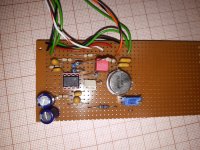I need to think about those lines for some time to get the gist of their true meaning haha.
Bias current of the LH0033? Or the quiescent current due to the biasing point?
I think the latter. So...then we have class A operation for about 1/5th the output current continuous rating?
Not too terrible.
With the Sennheisers I'd probably stay in Class A for the entire time.
32 Ohm phones would be not be the same story.
Class A isn't necessarily a design goal for me (no intention of offending anyone but...)
Class A for a headphone amp is slightly more practical than for any other power amplification. Spending 15W dissipation to produce 2W of usable power...
Joking aside, Class A, or AB, I'm not sure I have a preference. Just not Class B. And not Single ended.
If I can actually obtain the complement TO220 then I could try the CFP as you suggest
Bias current of the LH0033? Or the quiescent current due to the biasing point?
I think the latter. So...then we have class A operation for about 1/5th the output current continuous rating?
Not too terrible.
With the Sennheisers I'd probably stay in Class A for the entire time.
32 Ohm phones would be not be the same story.
Class A isn't necessarily a design goal for me (no intention of offending anyone but...)
Class A for a headphone amp is slightly more practical than for any other power amplification. Spending 15W dissipation to produce 2W of usable power...
Joking aside, Class A, or AB, I'm not sure I have a preference. Just not Class B. And not Single ended.
If I can actually obtain the complement TO220 then I could try the CFP as you suggest
Aside though, the noisy input may or may not be an issue (ill find out once I have a quiet hour to do some serious listening with Both channels.....)
Noise could be an issue. I'll have to see. Im using TL071 for testing but I have a bunch more input stage ICs to try for stability and ultimately sound quality.
Given some of these are very low noise, I imagine that the effective noise product resulting from a composite arrangement will be less.
But I have no idea if I am correct
Noise could be an issue. I'll have to see. Im using TL071 for testing but I have a bunch more input stage ICs to try for stability and ultimately sound quality.
Given some of these are very low noise, I imagine that the effective noise product resulting from a composite arrangement will be less.
But I have no idea if I am correct

The noise, distortion, and DC offset of the composite will be almost completely dominated by the op amp that controls the feedback loop - the LH0033 is just going along for the ride. The only possible problem is the additional phase shift of the LH0033 with fast amplifiers like the LM4562. However, the phase lag of the LH0033 is only 10 degrees at 50MHz (the unity gain frequency of the LM4562 / LME49710) so you will probably have no problems wrapping an LM4562 around an LH0033, even at unity gain. Still, it's worthwhile checking the final circuit with an oscilloscope to see if it's oscillating or not.
Thanks Monte,
It was my interpretation that the controlling op amp would have the most affect on noise etc, but my memory is so bad these days that I didn't want to be too assertive in that assumption.
To be totally fair, I have had good results with the likes of TL071 and LF351 JFET opamps, reasonably low noise and more limited BW and I plan to check stability with faster devices.
It was my interpretation that the controlling op amp would have the most affect on noise etc, but my memory is so bad these days that I didn't want to be too assertive in that assumption.
To be totally fair, I have had good results with the likes of TL071 and LF351 JFET opamps, reasonably low noise and more limited BW and I plan to check stability with faster devices.
- Status
- This old topic is closed. If you want to reopen this topic, contact a moderator using the "Report Post" button.
